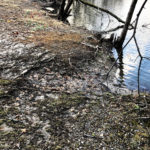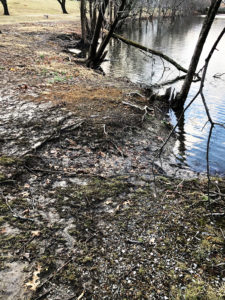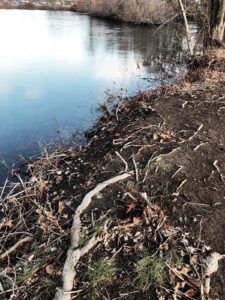
By Judy Singler
In September 2020, several Belmont residents removed more than 80 trees and shrubs from the south side of Clay Pit Pond. In an unauthorized action taken ostensibly to “enhance” the view of the pond, individuals visited the site on at least three occasions that month, cutting down 50-foot-tall trees, shrubs, vines, and other vegetation. The remaining trees at the edge of the pond were pruned of side branches to a height of 20 feet and more. Town officials eventually ordered a halt to the illegal tree cutting after calls from several concerned citizens.
Environmental Laws Exist to Protect our Wetlands
Cutting vegetation within 100 feet of a protected body of water is subject to state wetlands laws and requires a permit from the town’s Conservation Commission (ConCom). In this case, no permit was requested or granted.
In October, when the ConCom became aware of this activity, members began discussing options for the town. The contractor originally hired for management of invasive species around the pond had been unable to perform the work due to the Covid-19 crisis. He will inspect the site to assess current needs.
Because many tree and shrub stumps remained near the pond, creating a hazard to visitors, the Department of Public Works arranged for a contractor to remove the larger stumps in December, even as citizens raised concerns about possible erosion and siltation at the pond due to large areas without soil-stabilizing vegetation near the shoreline.

Bare ground, erosion, and cut stumps after illegal tree removal at Clay Pit Pond. Photo: Judy Singler
The Conservation Commission’s Role
This activity at Clay Pit Pond reveals the need for greater understanding in the community of our wetland areas and the regulations that protect them. In 1964, Massachusetts passed its Wetland Protection Act, Massachusetts General Laws (MGL) Chapter 131, Section 40. This law provides specific protections to wetlands and the public interest, including flood and pollution control, as well as groundwater supplies and wildlife habitat. It requires a thorough review of all proposed work that may impact any wetlands.
At the local level, Belmont’s ConCom administers the Wetlands Protection Act. This seven-member volunteer board is appointed by the Select Board and works with conservation agent Mary Trudeau to review and approve applications for work covered by the act.
At the state level, the Department of Environmental Protection (MassDEP) provides technical training to local conservation commissions and oversees administration of the law and develops policies and regulations, including fines for violations. Violators of the Wetlands Protection Act may be ordered to restore the property to its original condition and take other actions to mitigate the effects of the violation. In addition, they may incur criminal fines up to $25,000, imprisonment of up to two years, or both, or a civil penalty of up to $25,000 for each violation. Each day a violation continues is considered a separate offense.
Anyone wanting to work in a wetland resource area or within 100 feet of a wetland (the buffer zone) must obtain prior approval from the ConCom. Wetlands protection regulations are quite specific about the extent and type of work allowed. Activities covered include vegetation removal, regrading, and home construction, including additions, decks, and driveways. Commercial and industrial areas are also covered by the regulations.
Obtaining a permit from the ConCom requires filing of a Notice of Intent which includes the details of the proposed project, location of wetland resource areas and buffer zones, and steps that will be taken to protect them. ConCom representatives might visit the site to verify the boundaries of the protected areas, and typically a public hearing is held to allow abutters and other community members to ask questions or voice concerns.
Following the hearing, the ConCom will issue a permit known as an Order of Conditions, that specifies any special requirements needed to protect the public interests. Permits are denied if the impacts to the resource areas cannot be avoided or mitigated. These decisions may be appealed to MassDEP.
Surveying the Damage
Meanwhile, the land around Clay Pit Pond has suffered a considerable injury. Permits were never requested by citizens, who assumed their actions would be helpful to the town. Town officials must decide how to mitigate this damage and restore the soil around the pond before erosion and siltation affect water quality.
On March 8, the ConCom visited Clay Pit Pond to view the site and discuss planning for mitigation and restoration. Also in attendance were Patrice Garvin, town administrator; Roy Epstein, Select Board chair; and Jay Marcotte and Michael Santoro from the Department of Public Works, as well as some concerned citizens.
The site showed a great deal of exposed land, with many small stumps from shrubs protruding from loose soil, with exposed roots lining the banks. Some siltation was evident as well as several locations with minor erosion. Concerns were voiced over coming spring rains and the need for actions to mitigate the extensive loss of trees and shrubs. Initial plans include hiring a consultant to survey the area and provide recommendations. The land between the path and the pond banks needs to be stabilized immediately.
A Path Forward
The ongoing situation at Clay Pit Pond demonstrates the need for citizens to be aware of activity taking place in the town and to speak out when unusual actions are occurring. Meanwhile, advocating for appropriate follow-up to this unauthorized work at Clay Pit Pond could show how the town and community can work together to resolve a serious environmental problem.
The unlawful and ecologically damaging assault on the pond has created broader awareness of the need to stabilize the bank and manage the vegetation, especially the invasive plant species, around the entire pond. As a part of Belmont’s stormwater system, Clay Pit Pond is a significant resource, though one which requires regular assessment and care.
At the March 30 ConCom meeting Trudeau indicated her intent to seek funding to support a study of the needs of the pond. Town administrator Garvin has said that she will look for federal and state grants and other funding to support this effort. In this, she will follow guidance from Trudeau and the ConCom.
A review of the broader ecological health of the pond and a plan for its sustainability is essential to an effective action plan to assure that Clay Pit Pond will continue to be a valuable asset to Belmont and its residents.
Judy Singler is a member of the Council on Aging and the Housing Trust and a Town Meeting member for Precinct 6.



Sorry, the comment form is closed at this time.